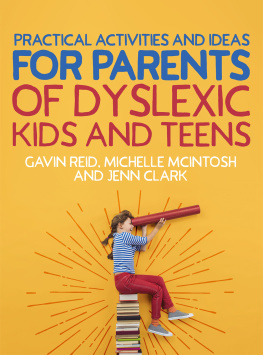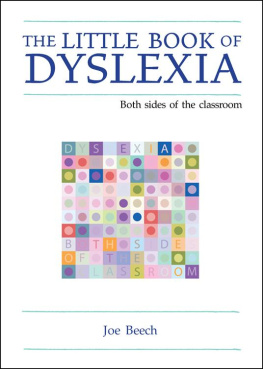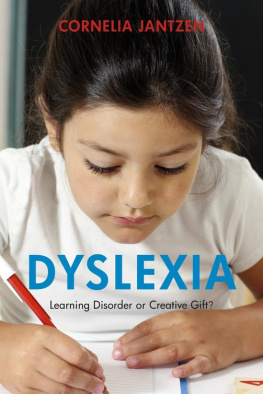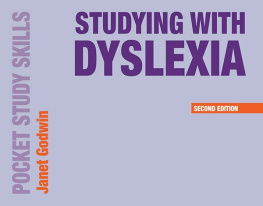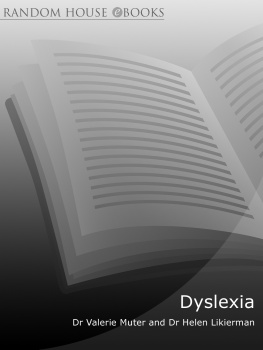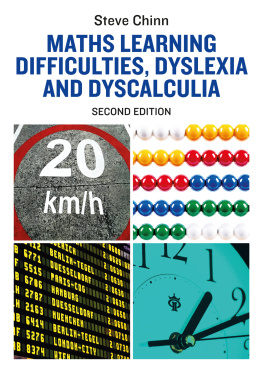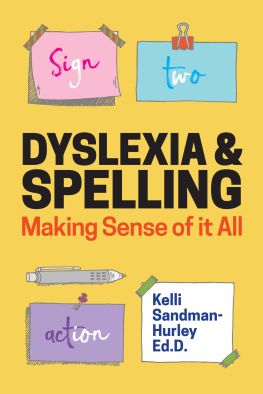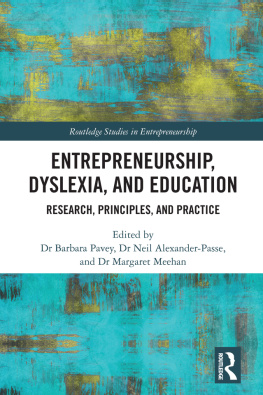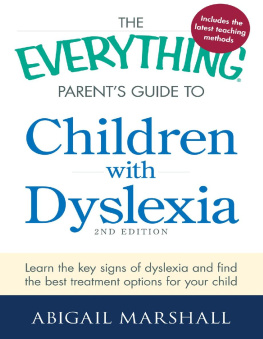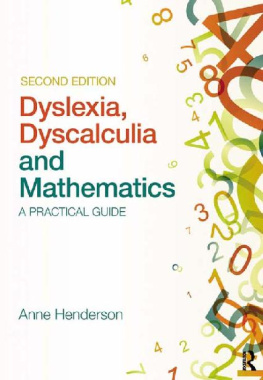
Dyslexia
IN THE
Early Years
A Handbook for Practice
GAVIN REID

Jessica Kingsley Publishers
London and Philadelphia
Contents
Preface
I have been involved in the field of dyslexia for many years in teaching, assessment, teacher training and research and I have always believed that the early years stage is the most crucial of all the education stages. It is in early years that the foundations for learning are laid, and where any potential difficulties can be identified. The early years stage for the purposes of this book is approximately from ages 37. Reference will be made to children younger and slightly older, but the focus is on nursery and early years.
In the case of dyslexia the research has always been convincing that early identification is the key and this leads to early intervention. It is this early intervention that holds the promise of eventual success, and that also leads to monitoring, meaning that no child with dyslexic-type difficulties should be missed. All too often now I have come across students in secondary and higher education who had only then been identified. Many had gone through the whole of their schooling undetected, and although in many cases they had met some successes, they were always quick to point out the challenges that confronted them. Of course how they dealt with those challenges did stand them in good stead and helped them develop more effective learning techniques, but this was at a cost. That cost was often in terms of increasing pressure of time as invariably they required more time to study and to complete work, and exam results were usually lower because they had to rush through work. Although the education system has now moved on in terms of exam accommodations and now considers assessment based on the students class work, there is still a need for a diagnosis, and that can often lead to further support. It should be clear therefore that early intervention is crucial and can lead to supports being put in place at the appropriate time.
The rationale behind this book therefore is to ensure that the text is accessible to all teachers irrespective of their current understanding of dyslexia. This is important as teachers are in the best position to spot difficulties as soon as they arise, and with knowledge and understanding of dyslexia they will be able to identify those children who are at risk of dyslexia and therefore at risk of failing. The aim is to prevent failure! If failure gets a hold too early, this can lead to learned helplessness and ultimately disaffection with school. This situation should never occur!
Much has been done in this area with UK government initiatives such as the landmark report from a panel led by Sir Jim Rose, the Independent Review of the Teaching of Early Reading (Rose 2006), the Early Years: Guide to the 0 to 25 SEND Code of Practice (DfE 2014) and reports from other organisations such as Guidance for Identifying and Supporting Young Children with Special Educational Needs for Early Years Settings, Schools and Support Services (Sure Start Childrens Centres 2010) and in Scotland the Early Years Framework (The Scottish Government 2008) and the National Practice Guidance on Early Learning and Childcare (The Scottish Government 2014). In July 2016 the Scottish government announced that local authorities are to offer new patterns of early learning and childcare to provide more flexibility for families. The Scottish Minister for Childcare and Early Years, Mark McDonald, stated that the early years are a crucial time in a childs development, and evidence has shown access to high-quality early learning and childcare helps improve educational outcomes (see, for example, Pickering 2016).
The area of early years is therefore seen as one that warrants considerable support and extended provision and this, coupled with the drive by expanding networks such as the British Dyslexia Association (BDA), Dyslexia Action and the Helen Arkell Dyslexia Centre, and government initiatives such as the Rose reports (2006, 2009), and the UK governments pledge to specialist funding for teacher training in dyslexia, presents a promising picture.
In the United States the Response to Intervention (RTI) model is now used extensively. The RTI approach focuses on the provision of effective reading instruction in the pre-school and 1st grade classroom. Progress monitoring is carried out and additional help (e.g., small group-based tutoring) is provided after documenting a failure to respond to effective instruction in the regular classroom. A hybrid model of identification that combines elements of the traditional and RTI approaches through identifying measures of phonological processing and rapid naming can be used with children who are non-responders in an RTI model. The key point is that the need to identify reading difficulties early has been established!
Many other countries are considering this approach, and becoming aware of its merits. While it is an important time for all children, for those with potential dyslexic difficulties, the importance of this stage in education cannot be underplayed. Some countries have a prominent approach for early intervention for example, in Canada the Orton-Gillingham (OG) approach is well established (see ).
We are fortunate in having at our disposal a huge array of exciting and innovative activities for the early years. These are well documented throughout this book, and technology is at the forefront. This is also described in detail in this book, in addition to how materials can be accessed and developed.
It is a pleasure for me to be writing this book. I have always promoted effective learning, and feel that helping children become better and more effective learners is of paramount importance. And for children with dyslexia, this is vital they need to become confident and independent learners to overcome the challenges of dyslexia. It is important, however, that there is government and school management commitment to ensuring that children at risk of dyslexia are identified and that appropriate next steps are established. Identification and support in the early years can help pave the way for this, and I sincerely hope this book helps to do this in some way.
Dr Gavin Reid
Edinburgh, Scotland, August 2016
Ages and Stages:
Early Years and Primary
Age | Year/Stage (by country) |
England | Scotland | Northern Ireland | US/Canada | Australia |
| Reception/ Early Years | Primary 1 | P1 | Pre-Kindergarten | Pre-school |
| Year 1/ Key Stage 1 | Primary 2 | P2 | Kindergarten | Reception/Foundation Year |
| Year 2/ Key Stage 1 | Primary 3 | P3 | First grade | Grade/Year 1 |
| Year 3/ Key Stage 2 | Primary 4 | P4 | Second grade | Grade/Year 2 |
| Year 4/ Key Stage 2 | Primary 5 | P5 | Third grade | Grade/Year 3 |
| Year 5/ Key Stage 2 | Primary 6 | P6 | Fourth grade | Grade/Year 4 |
1011 | Year 6/ Key Stage 2 | Primary 7 | P7 | Fifth grade | Grade/Year 5 |
Next page

